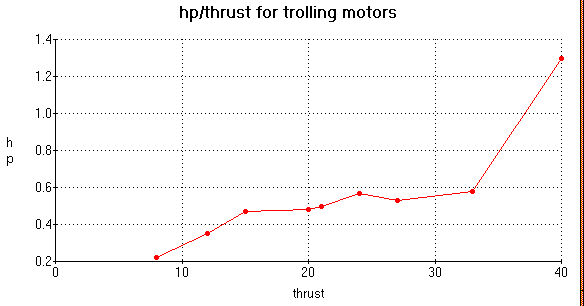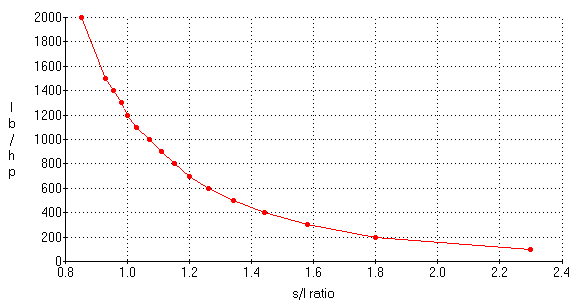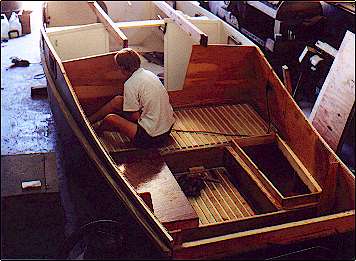
Frank Kahr's Robote.
Contents:
Contact info:
Jim Michalak
118 E Randall,
Lebanon, IL 62254Send $1 for info on 20 boats.
Jim Michalak's Boat Designs
118 E Randall, Lebanon, IL 62254
A page of boat designs and essays.
(1dec00) This issue applies some of the ideas of last issue's discussion to some small electric boats. Next issue, 15dec00, will discuss some small powerboat stuff.
|
|
Left:
Frank Kahr's Robote.
|
|
|
Electric Boats 2
FIRST A BIT OF REVIEW...
Lead and acid batteries are still the best bet for common electric boats since they are cheaper, more available, and lighter (believe it or not) than other suitable batteries. The battery used to start an auto or boat engine is a poor choice for an electric boat power source since they are designed to give a short big jolt of power, not a long even current like a deep cycle trolling motor battery. Deep cycle batteries are usually rated in "amp-hours" by how many amps of current they can deliver over a 20 hour period. Thus a "100 amp-hour" battery can deliver 5 amps per hour for 20 hours for a total of 100 amp hours. But small trolling motors usually draw about 20 amps per hour (at 12 volts). The higher current draw greatly reduces the total amout of current the battery will deliver. Here is a typical curve for a typical 100 amp-hour battery:

So the 20 amp motor will drain the battery in about 3.2 hours, about 70 amp hours total. Also it is best to not drain a battery below 70% of its total to prevent harming it in a way which will prevent future chargings. So the battery here might be limited to .7 x 3.2 hours = 2.2 hours.
Another recommended limit on the battery operation would be to keep current draw per hour within 20% of the total. So in this case the 20 amp motor is about the max to use with this battery.
A rough guess at trolling motor horse power is to apply the conversion of 1 hp equals 750 watts. A 12 volt motor using 20 amps is using 240 watts, or 240/750 = .32 hp.
In Douglas Little's book ELECTRIC BOATS he presents some power measurements from typical trolling motors. Remember that his "horse power ratings" are based on current measured TO the motor and not the acual measured output of the motor. Here is a chart I made from some of his tests:

Finally, here is a new chart of approximate boat performance, speed vs hp, that is in Little's book. This sort of chart takes no account of "fast" and "slow" hull shapes so is only a very general starting point for figuring performance. (A bit of explanation of this chart: the vertical scale is of weight in pounds divided by horsepower. The horizontal scale is a "speed ratio" of speed ,measured in knots, divided by the square root of the waterline length of the hull, measured in feet. A fine example of mixing apples and oranges but it has been standard for a long time. So if you know your boat's weight, power, and waterline length, you can figure out its speed.)

LET'S TAKE AN EXAMPLE...
...of my Piccup Squared. Let's assume it has a single 100 amp hour battery and a .3 hp motor that uses 20 amps per hour. As shown above the combination should run for about 2.2 hours at that rate and still have the reserve needed to prevent battery damage.
How far will it go? First we need to estimate the weight. The empty hull weighs about 100 pounds. The motor and battery together will weigh another 100 pounds. My weight and the usual boating junk might go another 200 pounds, so the the total rig will go about 400 pounds. Weight divided by horsepower will be about 1300. That corresponds to a speed ratio of about 1. Piccup Squared has a waterline length of about 10', so the speed in knots would be about 1.0 times the square root of 10, which is 3.1knots, which is 3.6 mph. With 2.2 hours of endurance the range would be about 2.2 x 3.6 = 8 miles.
The chart of hp vs thrust that I made from Little's data is a little spooky, as horsepower charts always seem to be. From the chart a rough guess at .3 hp would be a thrust of about maybe 11 pounds. You might be able to buy a motor that small but most likely you will have a larger motor running at part throttle. There is a bit of a warning here in that most small cheap trolling motors use resistors to throttle the motor. The resistors heat up, wasting energy so part throttle endurance may not be as predicted. More expensive motors use a system of pulsing the power, I believe, which eliminates the resistor heating and should improve endurance.
What would happen if Squared were powered by a 30 pound thrust motor, about .55 hp from Little's tests? That would be a draw of about .55 x 750/12 = 31 amps per hour. With a single battery you would be over Little's recommendation of 20% of the battery's capacity, but it can still be done. The battery curve shows an endurance of about 1.7 hours. Keeping to 70% of that would give a useful endurance of 1.7 x .7 = 1.2 hours. Weight to power will be about 400/.55 = 730 pounds per horse. That corresponds to a speed ratio of about 1.2. So boat speed will be about 1.2 times the square root of 10, which is 3.16 knots, which is 4.3 mph. That is indeed about what Squared did when I tested it with the little battery, but while that battery would die after about 15 minutes, the full sized trolling battery should last 1.2 hours for a range of about 5 miles.
Finally let's say you add a second battery to the 30 pound thrust motor. If each battery draws half of the load, 15 amps per hour, then the endurance is about 5 hours, or 3.5 hours if you stick to the 70% rule. For a total range of about 3.5 x 4.3 = 15 miles.
NEXT, I GOT THIS LETTER...
...after posting the last issue. So here is the best first-hand experience I've heard from anyone concerning using a simple electric set up. It was from Clyde Osterhout:
"... For the past 12 years, I have been using several trolling motors with my 17' Grumman Eagle canoe. Most of the time, I have been cruising on mainly flat waters with mild to moderate (1-3 mph) currents. These include the St. Lawrence River, in the 1000 Islands area, the Pocomoke River system in MD, the Susquehanna river, near Three Mile Island, and various lakes and ponds around the Mid-Atlantic region. Maybe 2500 miles or so under power in all. Here are a few observations:
1. With a canoe, at full power, I get about 6-8 miles out of a charge. At 3/4 power, I get about 8-10 miles. I never had enough patience to see how far I could go on anything less. I have discovered that I can go considerably farther with the canoe than the manufacturers estimate I should be able to go. That's because their estimates are based on much heavier boat, with a great deal more resistance to forward motion. I doubt that a converted row boat would be as successful as my canoe. I conclude therefore that an electric boat ought to be narrow, long, and as light as possible. Anything "extra" will reduce range.
2. The motors seem to propel my canoe at about 3.25 mph at the highest setting. That's true of an 18 lbs of thrust motor, as well as a 30 lbs motor. The 30 lbs motor has a great deal more "kick", and works much better in the wind, but the top speed does not seem to be much different. This must be due to the props, as you have already observed. I just obtained an older 30 lbs trolling motor with a small, 3 bladed prop that seems to push my canoe MUCH faster, maybe as much as 5 MPH. I haven't had a chance to do any real testing yet, but it is obvious that prop design is very important for electric powered boats.
3. Electric boats aren't fast. That much is painfully obvious! But the trolling motor powered canoe can maintain a higher average speed than one that is paddled by average paddlers. It works better in windy conditions, and is great for going against a stiff current. It is also quiet, even quieter than paddling. And if one has kids (as I do), it helps to have a free hand or two to deal with them as they squirm around. Finally, many lakes here in PA won't allow anything BUT electric motors, making the choice of what kind of power to use an easy one. So one can find some truly practical reasons for using a motor.
4. DO NOT USE an electric motor in salt water unless it is specifically designed for salt water use. It does ugly things to an electric motor.
What I would love to find would be a "cruising canoe", a long (16-18 foot), narrow (36-40 inches, max), light (less than 120 lbs) boat with a minimal cabin (for changing, napping, or bathroom purposes, not really for camping) kind of thing that would be good for bird watching, swimming, and good clean quiet family fun. Any chance? Hey, a guy can dream, can't he?
Yes, I use 120 amp deep cycle trolling motors. They make a huge difference. Car batteries, as you have pointed out, simply don't work. And not all deep cycle batteries are the same. Sears Die Hards, for instance, consistently put out more "umph" than Walmart batteries of the same amperage. Never could figure out why. They all seem to last about the same length of time, though.
In the end, electric boats aren't about getting anywhere. They are about enjoying the ride itself. Thanks for putting up with my endless observations! Clyde"
THE NEXT EXAMPLE WILL BE...
..."Electron", a new design presented in the boat feature below.
NEXT TIME...
Will present some more powerboat testing, this time with gas motors.
ELECTRON

ELECTRON, ELECTRIC CUDDY BOAT, 18' X 5', 900 POUNDS EMPTY
Electron was an interesting project done for a man who had done his homework on electric boats. In particular he had studied Doug Little's great book ELECTRIC BOATS. He wanted a cuddy cabin boat capable of some cruising, the ability to go about 30 miles on batteries when desired.
We started with my old Fatcat2 design, stretched it to 18' and narrowed it to 5', which made it visually a lot sleeker. He told me right off the bat that his figures showed he would need six trolling motor batteries to get the desired range while using a 24 volt, 2hp Minnkota trolling motor at half throttle.
To guess at performance you first guess at the total weight. The batteries will weigh about 400 pounds total and the motor about 60 pounds. With wires and such the power system should go about 500 pounds. The hull structure is guessed at 400 pounds, so the total empty weight might be 900 pounds. Let's add 400 pounds for the skipper and guest and some gear. The total comes to 1300 pounds in this set up.
Next we guess at the waterline length. Let's say 17' for this 18' boat with plumb stem and stern.
Now we go up to the performance chart to guess at the speed of the boat. At full throttle we might have a lb/hp ratio of 1300/2 = 650. The chart predicts a speed ratio of about 1.15. The square root of the water line length is about 4.12. So the chart predicts a top speed of 1.15x4.12=4.7 knots which is 5.4 mph. Not bad.
Cruising at 1 hp gives a lb/hp ratio of 1300. The chart predicts a speed ratio of about .97. So cruise speed should be about .97x4.12=4knots which is 4.6 mph. Not bad (and it shows how boats can cut their power a lot and just slow down a little).
Now let's guess at the endurance. The 24 volt motor running at 1 hp should use 750/24 = 31 amps per hour. The six batteries in the plan are like the 12v, 100 amp-hour battery shown in the above chart (power-wise, they are 12x100=1200 watt-hours each for a total of 7200 watt-hours for the six). They must be first wired two in series to produce three 24 volt sources. So in use they will look like three 24 volt batteries, 100 amp-hours each.

If each battery pair pulls its share of the load, about 31/3=10 amps per hour, then the chart estimates an endurance of about 8 hours. keeping the battery draw to 70% maximum would imply an endurance of 8x.7=5.6 hours. At cruise that means 5.6 x 4.6=26 miles.
At full 2hp (1500 watts per hour) the endurance would be about .7 x 3hours = 2.1 hours for a range of 2.1 x 5.4 = 11 miles.
Another check to make is Little's rule of not drawing more than 20% of the power per hour. So a 2 hp motor (1500 watts) needs at least 7500 watt-hours total and the battery bank shown is about minimum.
One might ask about putting a gas motor on Electron. I'm quite sure it will not plane under control in the usual safe sense. So there is little point in using over about 4 hp. A modern 4 cycle engine of that power will run for ever on a little bit of gas, and even a junker 2 cycle that size will burn about a gallon every three hours or so. A tiller extension is mandatory for proper trim, very easily done. For that matter the electric will need a tiller extension or remote steering for proper trim.
I think this hull would be a good starting point for a sail boat. The lines are right. You will have to rethink the cockpit, trying to make it more watertight. There is a great temptation to use the batteries for ballast but I'm not so sure this boat is a good candidate for a self-righting design because it's side and cabin are low. There might be a compromise where maybe two batteries are used, keeping the battery compartment small and yet with enough endurance for 8 miles or so in calm conditions. The weight of the two batteries might steady the boat but it would not be self righting. The hull would easily take a 100 square foot balanced lug sail and leeboard.
Electron is built from eight sheets of 3/8" plywood and three sheets of 1/2" plywood, using taped seams and jigless construction requiring no lofting.
Electron plans are $25 until one is built and tested.
Prototype News
Some of you may know that in addition to the one buck catalog which now contains 20 "done" boats, I offer another catalog of 20 unbuilt prototypes. The buck catalog has on its last page a list and brief description of the boats currently in the Catalog of Prototypes. That catalog also contains some articles that I wrote for Messing About In Boats and Boatbuilder magazines. The Catalog of Prototypes costs $3. The both together amount to 50 pages for $4, an offer you may have seen in Woodenboat ads. Payment must be in US funds. The banks here won't accept anything else. (I've got a little stash of foreign currency that I can admire but not spend.) I'm way too small for credit cards.
Here are the prototypes abuilding that I know of:
Caprice: A brave and experienced builder in Texas is making the 25' Caprice water ballasted sailboat. A big project.Here the builder plugs away at the aft deck.

Jon Jr has been completed by Joe Leinweber and Dan Ellis and tested to a certain degree. Click here to read about the test and the surprize ending! ("The waters are only safe until next time!")

Mayfly12: A Mayfly12 is now completed and has been sailed. Waiting for final photos but here is an initial photo.

AN INDEX OF PAST ISSUES
Herb builds AF3 (archived copy)
Hullforms Download (archived copy)
Plyboats Demo Download (archived copy)